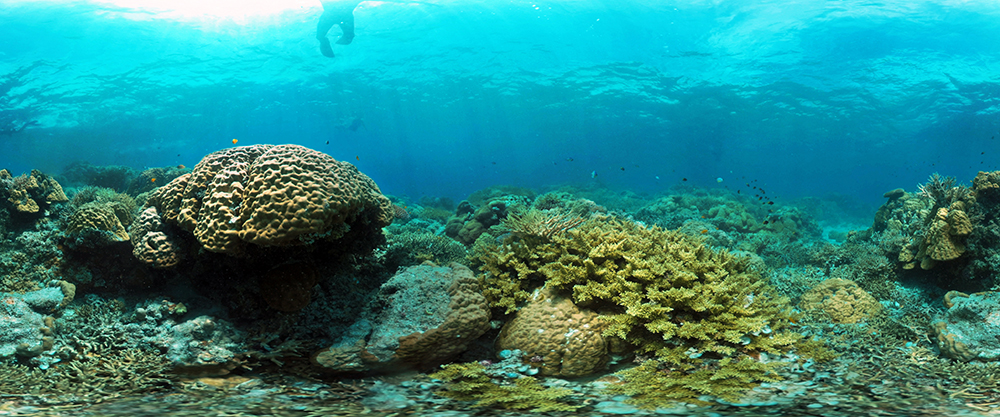In 2016, CORAL began an exciting new partnership with the Virtual Human Interaction Lab (VHIL) at Stanford University. Three key players met to kickstart this collaboration: Dr. Michael Webster, CORAL’s Executive Director, Dr. Jeremy Bailenson, VHIL’s Director, and Dr. Robert Richmond, Director of the University of Hawaiʻi’s Kewalo Marine Laboratory. Although they didn’t know it at the time, their meeting would lead to one of the most popular virtual reality films presented at Tribeca.
Their discussion centered around one key question: How can virtual reality be used to advance coral reef conservation in the face of climate change? The answer became clear when Dr. Richmond, who is also a CORAL Board member, suggested that VHIL staff attend a Palauan congressional meeting to show leaders how their coral reefs looked in virtual reality. This meeting would provide decision-makers and leaders with an immersive opportunity to learn more about coral reefs, their importance, and the threats they face. And then, hopefully, to positively influence the trajectory of future laws and regulations affecting coral reefs and coral reef conservation.
With CORAL’s help, two VHIL staff members – Tobin Asher and Elise Ogle – traveled to Palau to film underwater virtual reality footage. Asher and Ogle’s visit coincided not only with the congressional meeting but also with a Stanford University Overseas Seminar, taught by Dr. Robert Dunbar and Dr. Stephen Monismith of Stanford University and Dr. Richmond. Asher and Ogle were able to join Stanford students and staff from the Palau International Coral Reef Center (PICRC) on daily field expeditions and filmed a diverse selection of both healthy and degraded reefs.

The congressional meeting took place on July 7, 2017, at PICRC; Palauan delegates and senators attended the event, PICRC staff moderated the event and Dr. Richmond and Dr. Dunbar gave presentations on coral reef conservation and management. The goal of the meeting was to connect decision-makers and scientists and to facilitate understanding of how climate change and local stressors are affecting coral reefs in Palau and the people who depend on them.
After the presentations, Asher and Ogle ran personalized demonstrations of virtual underwater footage from Palauan reefs. Many congressional members had never experienced VR technology before, and for some senators, it was their first time seeing an underwater landscape of coral reefs.
An especially impactful underwater scene showed a popular snorkeling site, with tourists inadvertently kicking corals on the reef. Experiencing coral reefs in virtual reality and seeing the threats they face helped attendees understand the importance of protecting coral reefs, especially the popular tourist sites. Soon after the experience, Palauan senators introduced initiatives that would reduce the number of people at popular tourist sites and also made commitments to further research to protect coral reefs.
The collaboration between the VHIL and CORAL didn’t end after the landmark congressional meeting. Asher and Ogle attended the 2017 CORAL Prize event last September and led individual immersive experiences for attendees. CORAL staff experienced bustling Palauan coral reefs and saw the power of virtual reality for conservation.

VHIL staff also used the virtual reality footage from Palau to create Coral Compass: Fighting Climate Change in Palau, an underwater VR film that was showcased at the Tribeca Film Festival in April 2018. The film was a breakout star at the festival, garnering praise like “the best… virtual reality experience on offer at this year’s Tribeca Film Festival” from Observer Magazine. The film’s upbeat message helped connect viewers to coral reefs, and its interactive nature contributed to its success. As underwater filmmaker Ogle points out, “When you put the headset on and you feel immersed, that’s really what drives this experience as far as creating attitude and behavior changes for coral reefs.”
The VHIL team is now working to bring Coral Compass to popular Virtual Reality platforms, like SteamVR, Oculus and VIVEPORT. The film is available on Oculus here.
Asher believes the message of hope was critical to the film’s impactful debut. “One of the things that was important to us was that it wasn’t a doom and gloom story. We wanted to emphasize that there are things people can do to combat what’s happening, and if we take action we can see positive results for coral reefs.”